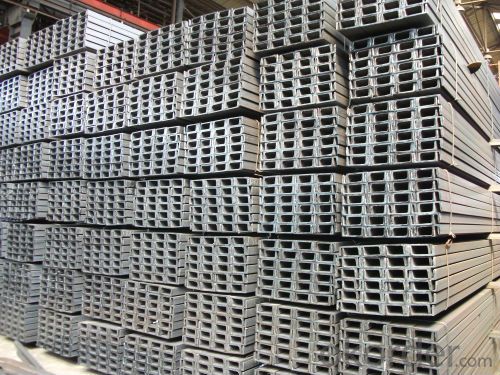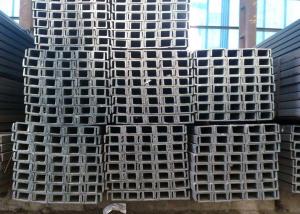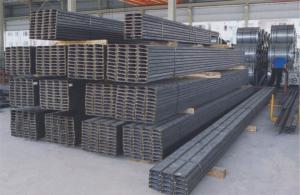U Channel Beam Channel Iron Sizes Steel
- Loading Port:
- Tianjin
- Payment Terms:
- TT or LC
- Min Order Qty:
- 28 m.t.
- Supply Capability:
- 40000 m.t./month
OKorder Service Pledge
OKorder Financial Service
You Might Also Like
Product Description:
OKorder is offering U Channel Beam Channel Iron Sizes Steel at great prices with worldwide shipping. Our supplier is a world-class manufacturer of steel, with our products utilized the world over. OKorder annually supplies products to European, North American and Asian markets. We provide quotations within 24 hours of receiving an inquiry and guarantee competitive prices.
Product Applications:
U Channel Beam Channel Iron Sizes Steel are ideal for structural applications and are widely used in the construction of buildings and bridges, and the manufacturing, petrochemical, and transportation industries.
Product Advantages:
OKorder's U Channel Beam Channel Iron Sizes Steel are durable, strong, and resist corrosion.
Main Product Features:
· Premium quality
· Prompt delivery & seaworthy packing (30 days after receiving deposit)
· Corrosion resistance
· Can be recycled and reused
· Mill test certification
· Professional Service
· Competitive pricing
Product Specifications:
channel iron sizes steel u channel beam
1.Specification: from 5# to 30#
2.Size 50*37 to 300*89
3.Material:Q235 SS400 Q345
| U CHANNEL BEAMS(JIS) | ||||
| MATERIAL:Q235/SS400/ST37-2 and Q345/ST52 | ||||
| Size | Size/mm | Theoretical Weight | ||
| h | b | d | kg/m | |
| 75*40*3.8 | 75 | 40 | 3.8 | 5.3 |
| 75*40*4.0 | 75 | 40 | 4 | 5.6 |
| 75*40*4.5 | 75 | 40 | 4.5 | 5.85 |
| 75*40*5.0 | 75 | 40 | 5 | 6.92 |
| 100*50*3.8 | 100 | 50 | 3.8 | 7.3 |
| 100*50*4.2 | 100 | 50 | 4.2 | 8.03 |
| 100*50*4.5 | 100 | 50 | 4.5 | 8.97 |
| 100*50*5 | 100 | 50 | 5 | 9.36 |
| 125*65*5.2 | 125 | 65 | 5.2 | 11.66 |
| 125*65*5.3 | 125 | 65 | 5.3 | 12.17 |
| 125*65*5.5 | 125 | 65 | 5.5 | 12.91 |
| 125*65*6 | 125 | 65 | 6 | 13.4 |
| 125*65*5.5 | 150 | 75 | 5.5 | 14.66 |
| 150*75*5.7 | 150 | 75 | 5.7 | 16.71 |
| 150*75*6 | 150 | 75 | 6 | 17.9 |
| 150*75*6.5 | 150 | 75 | 6.5 | 18.6 |
| U CHANNEL BEAMS(CHINESE STANDARD) | ||||
| MATERIAL:Q235/SS400/ST37-2 and Q345/ST52 | ||||
| Size | Size/mm | Theoretical Weight | ||
| h | b | d | kg/m | |
| 5 | 50 | 37 | 4.5 | 5.438 |
| 6.3 | 63 | 40 | 4.8 | 6.634 |
| 8 | 80 | 43 | 5 | 8.045 |
| 10 | 100 | 48 | 5.3 | 10.007 |
| 12.6 | 126 | 53 | 5.5 | 12.318 |
| 14a | 140 | 58 | 6 | 14.535 |
| 14b | 140 | 60 | 8 | 16.733 |
| 16a | 160 | 63 | 6.5 | 17.24 |
| 16 | 160 | 65 | 8.5 | 19.752 |
| 18a | 180 | 68 | 7 | 20.174 |
| 18 | 180 | 70 | 9 | 23 |
| 20a | 200 | 73 | 7 | 22.637 |
| 20 | 200 | 75 | 9 | 25.777 |
| 22a | 220 | 77 | 7 | 24.999 |
| 22 | 220 | 79 | 9 | 28.453 |
| 25a | 250 | 78 | 7 | 27.41 |
| 25b | 250 | 80 | 9 | 31.335 |
| 25c | 250 | 82 | 11 | 35.26 |
| 28a | 280 | 82 | 7.5 | 31.427 |
| 28b | 280 | 84 | 9.5 | 35.823 |
| 28c | 280 | 86 | 11.5 | 40.219 |
| 30a | 300 | 85 | 7.5 | 34.463 |
| 30b | 300 | 87 | 9.5 | 39.173 |
| 30c | 300 | 89 | 11.5 | 43.833 |
| 32a | 320 | 88 | 8 | 38.083 |
| 32b | 320 | 90 | 10 | 43.107 |
| 32c | 320 | 92 | 12 | 48.131 |
| 36a | 360 | 96 | 9 | 41.814 |
| 36b | 360 | 98 | 11 | 53.466 |
| 36c | 360 | 100 | 13 | 59.928 |
| 40a | 400 | 100 | 10.5 | 58.928 |
| 40b | 400 | 102 | 12.5 | 65.208 |
| 40c | 400 | 104 | 14.5 | 71.488 |
FAQ:
Q1: Why buy Materials & Equipment from OKorder.com?
A1: All products offered byOKorder.com are carefully selected from China's most reliable manufacturing enterprises. Through its ISO certifications, OKorder.com adheres to the highest standards and a commitment to supply chain safety and customer satisfaction.
Q2: How do we guarantee the quality of our products?
A2: We have established an advanced quality management system which conducts strict quality tests at every step, from raw materials to the final product. At the same time, we provide extensive follow-up service assurances as required.
Q3: How soon can we receive the product after purchase?
A3: Within three days of placing an order, we will begin production. The specific shipping date is dependent upon international and government factors, but is typically 7 to 10 workdays.



- Q: How do steel channels contribute to sustainable construction practices?
- Steel channels contribute to sustainable construction practices in several ways: 1. Durability: Steel channels are highly durable and have a long lifespan, which reduces the need for frequent replacements or repairs. This durability minimizes waste generation and reduces the consumption of materials over time. 2. Recyclability: Steel is one of the most recycled materials in the world. Steel channels can be easily recycled at the end of their lifespan, reducing the demand for new steel production and saving energy and resources. 3. Efficient use of materials: Steel channels can be designed to have optimal strength-to-weight ratios, allowing for the use of less material while maintaining structural integrity. This reduces the overall weight of the construction, leading to lower transportation and foundation costs. 4. Energy efficiency: Steel channels are often used in framing systems, which can help improve the energy efficiency of buildings. Steel framing allows for better insulation, reducing energy consumption for heating and cooling. Additionally, steel channels can be combined with other sustainable practices, such as using renewable energy sources or incorporating green building materials. 5. Resistance to natural disasters: Steel channels have high strength and resistance to fire, earthquakes, and extreme weather events. By using steel channels in construction, buildings can be designed to withstand these hazards, reducing the damage caused and increasing the safety and resilience of the structures. 6. Reduced construction waste: Steel channels can be prefabricated off-site, leading to reduced construction waste generation. Prefabrication allows for better quality control, minimizes on-site material waste, and reduces construction noise and disruption. Overall, steel channels contribute to sustainable construction practices by promoting durability, recyclability, efficient use of materials, energy efficiency, resistance to natural disasters, and reduced construction waste.
- Q: Can steel channels be used for solar panel support structures?
- Yes, steel channels can be used for solar panel support structures. Steel channels provide strength, stability, and durability, making them suitable for supporting the weight of solar panels. Additionally, steel channels offer flexibility in design and can be customized to meet specific project requirements.
- Q: Geometrical dimension of channel steel channel 8
- GB material. Now a lot of non-standard (lower tolerance. National standard difference 5~7%)
- Q: Can steel channels be used for fencing?
- Yes, steel channels can be used for fencing. Steel channels are versatile and strong, making them suitable for various fencing applications. They can be used as posts, rails, or supports in a fencing system. Steel channels provide durability and stability, making them an excellent choice for both residential and commercial fencing projects. Additionally, steel channels can be easily customized to meet specific fencing requirements, such as height, design, and security needs. Overall, steel channels offer a reliable and long-lasting solution for fencing purposes.
- Q: Can steel channels be used in the construction of fencing or barriers?
- Yes, steel channels can be used in the construction of fencing or barriers. Steel channels are versatile and strong structural components that can provide the necessary support and stability required for fencing and barrier systems. They can be used to create a framework for the fence or barrier, providing a solid structure to hold the fencing material or panels in place. Steel channels are durable and resistant to weather and corrosion, making them suitable for outdoor applications. They can be easily customized to fit specific design requirements and are available in various sizes and thicknesses to accommodate different fencing or barrier needs. Additionally, steel channels can be welded, bolted, or secured using other fastening methods, ensuring a secure and long-lasting fence or barrier system.
- Q: What are the acceptance criteria for channel steel?
- Channel steel is mainly used in building structures and vehicle manufacturing. In use, it requires better welding, riveting performance and comprehensive mechanical properties.
- Q: 16A channel steel size requirements are national standards Oh!
- The national standard for channel steels is "hot rolled steel" GB/T706-2008
- Q: What are the different methods of surface preparation for steel channels?
- There are several methods of surface preparation for steel channels, each serving a specific purpose and achieving different results. Some of the most commonly used methods include: 1. Abrasive blasting: This method involves using high-pressure air or water to propel abrasive particles onto the surface of the steel channels. It effectively removes rust, scale, and other contaminants, leaving a clean and roughened surface ready for further treatment or coating. 2. Chemical cleaning: This method involves using chemicals to remove surface contaminants and oxides from the steel channels. Acid pickling is a common chemical cleaning process, where the channels are immersed in an acid bath to dissolve rust and scale. Alkaline cleaning is another method that uses alkaline solutions to remove organic contaminants. 3. Mechanical cleaning: This method involves using mechanical tools such as wire brushes, scrapers, or sandpaper to physically remove contaminants from the surface of the steel channels. It is often used for smaller areas or localized cleaning requirements. 4. Power tool cleaning: This method involves using power tools such as grinders, sanders, or wire brushes to mechanically clean the surface of the steel channels. It is effective for removing heavy rust, mill scale, and coatings. 5. Solvent cleaning: This method involves using solvents to dissolve and remove contaminants from the surface of the steel channels. It is typically used for light cleaning and degreasing purposes. 6. Water jetting: This method involves using high-pressure water jets to clean the surface of the steel channels. It can effectively remove loose rust, paint, and other debris. It is important to select the appropriate method of surface preparation based on the specific requirements of the steel channels, such as the extent of surface contamination, the desired level of cleanliness, and the type of coating or treatment to be applied. Following the appropriate surface preparation process ensures better adhesion of coatings, improved corrosion resistance, and enhanced overall performance of the steel channels.
- Q: Are steel channels suitable for the power generation manufacturing industry?
- Certainly, the power generation manufacturing industry finds steel channels to be highly appropriate. Steel channels are extensively employed in the production of power generation equipment, encompassing turbines, generators, and transformers. The remarkable strength and durability of steel render it an exceptional material for bearing substantial loads and enduring the frequently encountered high temperatures and pressures in power generation procedures. Moreover, steel channels can be conveniently fabricated and tailored to meet the precise design specifications of power generation equipment. They offer stability, structural soundness, and dependability, thereby positioning themselves as a fitting selection for the power generation manufacturing industry.
- Q: Industrial plant pipe hanger expansion bolts, why add a section of channel, and then connect the screw rod?. The outer expansion bolt of the embedded beam is connected with a section of channel steel, and then the steel bar is hung under the channel steel. Why do you want to do this? What are the advantages?
- Safety and stability analysis is the first form of support, a little better, attention is to consider a firm point
Send your message to us
U Channel Beam Channel Iron Sizes Steel
- Loading Port:
- Tianjin
- Payment Terms:
- TT or LC
- Min Order Qty:
- 28 m.t.
- Supply Capability:
- 40000 m.t./month
OKorder Service Pledge
OKorder Financial Service
Similar products
Hot products
Hot Searches
Related keywords



























